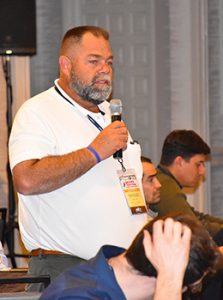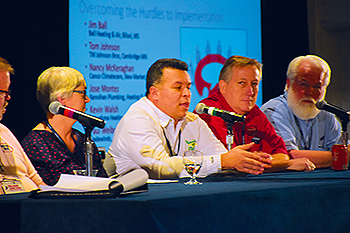RECRUITMENT
One of the biggest issues facing the HVAC Industry today is the
shortage of capable service and installation technicians. This can
definitely be a problem in the Performance-Based Contracting
arena because of the necessary technical requirements for measuring
and diagnosing system defects.

Mike Greany of All Pro Plumbing and Heating asks the panel about how they recruit technicians into their companies.
Q: Mike Greany, All Pro Heating and Air, Ontario, CA: We currently try to attract experienced technicians into our company through our distributor, R.E. Michel, and NCI’s TIPP program, but are not getting that many qualified applicants. What do you do to recruit from outside the world of Performance for qualified technicians?
A: McKeraghan: We sit on the board of a college and have access to their students. We are also involved in Skills Ontario ‘ a competition held for high school students and another for post-secondary students.
Students go through an interview and then take a theoretical and practical exam. Because we are on that committee, we get to see who we might want to hire. We prefer to hire young people.
We hire for attitude because we can teach them everything else they need to be successful. If you don’t have the proper attitude, I want nothing to do with you, even if you are a wonderful mechanic.
We also have co-op students at both the high school and college level. We have our pick of those young people who participate.
Making commitments to those kinds of institutions is very beneficial. The employees we’ve hired through those programs have turned out to be very wonderful.
Jim Ball: We do the same thing through our local college. We hire from the college and start them in our maintenance department. We then train them for two or three years before they can run a service call.
Q: Dominick: Do any of you hire from outside the industry who have mechanical aptitude from a different career?
A: Wieboldt: We’ve hired several veterans ‘ especially Airforce pilots. We find their pilot training, engineering background, and motivation to be wonderful. It feels good to provide them jobs after they served the U.S. We have been successful in this and so have they.
I am surprised more of us aren’t doing this. There is a growing pool of veterans being reintroduced into the workforce and they are looking for something to do.
Montes: We had to let go of the idea of hiring only people with experience. Why? Because we couldn’t find many who fit into our culture. When we moved past that we hired a technician who’s background was aviation mechanic. We’ve also brought in a coal miner as well as some young men with just a tech school education and no experience at all.
We’ve always been big on training. For us, it was just a matter of getting them incorporated into our culture and letting them spend time with our veteran technicians. We knew their coming up to speed wouldn’t happen overnight. It was an investment in our future and right now we are very comfortable that we have the right team.
KEEPING SCORE
Implementing Performance into a business culture
also requires measurement and diagnostics.
In this section, the panel addresses how they kept score and
held their team accountable.
Q: Dominick: I think everyone here knows that NCI’s motto is, ‘If You Don’t Measure, You’re Just Guessing.’ Of course, we’re talking about the technical measurement. But we’re also talking about more than that. How do you keep score? Do you have goal boards or other methods for keeping your team informed about their progress?

Jose Montes (center) shares his insights on implementing performance into Kennihan’s Plumbing and Heating.
A: Ball: We put up goal boards. We started with a coaching program that used goal boards to show how we were doing. We experimented with how they looked, then looked at sales. We originally started with dollar amounts, but that became overwhelming. So we went to using units. That worked better. We meet weekly on Wednesday mornings.
For more than a year, I get a report at the end of the day and I text the entire team with information based on the daily numbers. Then on Wednesday morning, we discuss what the numbers should be and how to get there.
Walsh: We use different boards. For example, we track what was sold each day, including how many man-hours they sold. This lets our installation department know what to expect. That really comes into play during the early spring when things are a bit sketchy.
The service manager tracks things like lead generation, average ticket dollar amount, callback, full revenue, and so on.
So we use boards for tracking and planning throughout the company.
Q: Everett Williamson, Bremac, Inc., Mechanicsville, VA: As far as your service technicians go, how do you evaluate them? I know in his class Kevin Walsh says he has steps or levels he uses for such evaluations. How do you know the tech has gotten to the next level? I know you can send them to classes, but are they actually using the NCI performance methods?
A: Tom Johnson: We used to do the old-school 1-10 scorecard system where one of my managers or I would sit down with them and discuss their grade.
This past year, we changed that a bit. We do the interview first and have them tell us where they want to go. We didn’t always understand their goals. Once that understanding is on the table, together we chart the path to get them there.
This was a very enlightening process. The result is that together we create very specific goals written down to help them achieve what they want to achieve. The key was not to assume what they want to do.












Recent Comments